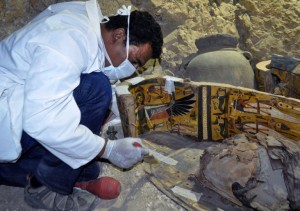Egyptian archaeologists have discovered eight mummies in a 3,500-year-old tomb near the southern city of Luxor.
The tomb, discovered in the Draa Abul Nagaa necropolis near the famed Valley of the Kings, also contained colourful wooden coffins and more than 1,000 funerary statues.
The tomb, discovered in the Draa Abul Nagaa necropolis near the famed Valley of the Kings, is not fully excavated yet.
The mysterious death vault from roughly 1,500 to 1,000 B.C belonged to a nobleman named Userhat who worked as the city judge, the Antiquities Ministry said in a statement.
Head of the archaeological mission, Mostafa el-Waziri, said: “There are 10 coffins and eight mummies. The excavation is ongoing.”
The tomb comprised an open courtyard leading to two halls, one containing four ancient coffins and the other including a chamber that houses six.
It was opened to add more mummies during the 21st Dynasty, about 3,000 years ago, to protect them during a period when tomb-robbing was common.
Antiquities Minister Khaled el-Enany said: “It was a surprise how much was being displayed inside.
“We found a large number of Ushabti (small carved figurines), more than 1,000 of them.
“This is an important discovery.”
Ushabti figurines were often placed with the deceased in ancient Egyptian tombs to help with responsibilities in the afterlife.
Inside the tomb, archaeologists wearing white masks and latex gloves inspected the coffins.
They were covered with intricate drawings in red, blue, black, green, and yellow, and featured the carved faces of the dead.
The coffins were mainly well-preserved, though some had deteriorated and broken over the years. Archaeologists also examined a mummy wrapped in linen which was inside one of the coffins. White, orange, green, and patterned pots were also found in the tombs.
“It is a T-shaped tomb (which) consists of an open court leading into a rectangular hall, a corridor and an inner chamber,” the ministry said in a statement.
A nine-metre shaft inside the tomb held the Ushabti figurines, as well as “wooden masks and a handle of a sarcophagus lid,” the ministry said.
Another room in the tomb was also discovered, though it has not yet been completely excavated, it said.

Nevine el-Aref, the spokeswoman for the antiquities ministry, said “there is evidence and traces that new mummies could be discovered in the future.”
Earlier this year, Italian researchers began a fresh investigation into the King Tutanhkamun’s resting place with the hope they will find the “discovery of the century”.
Ask me anything
Explore related questions












